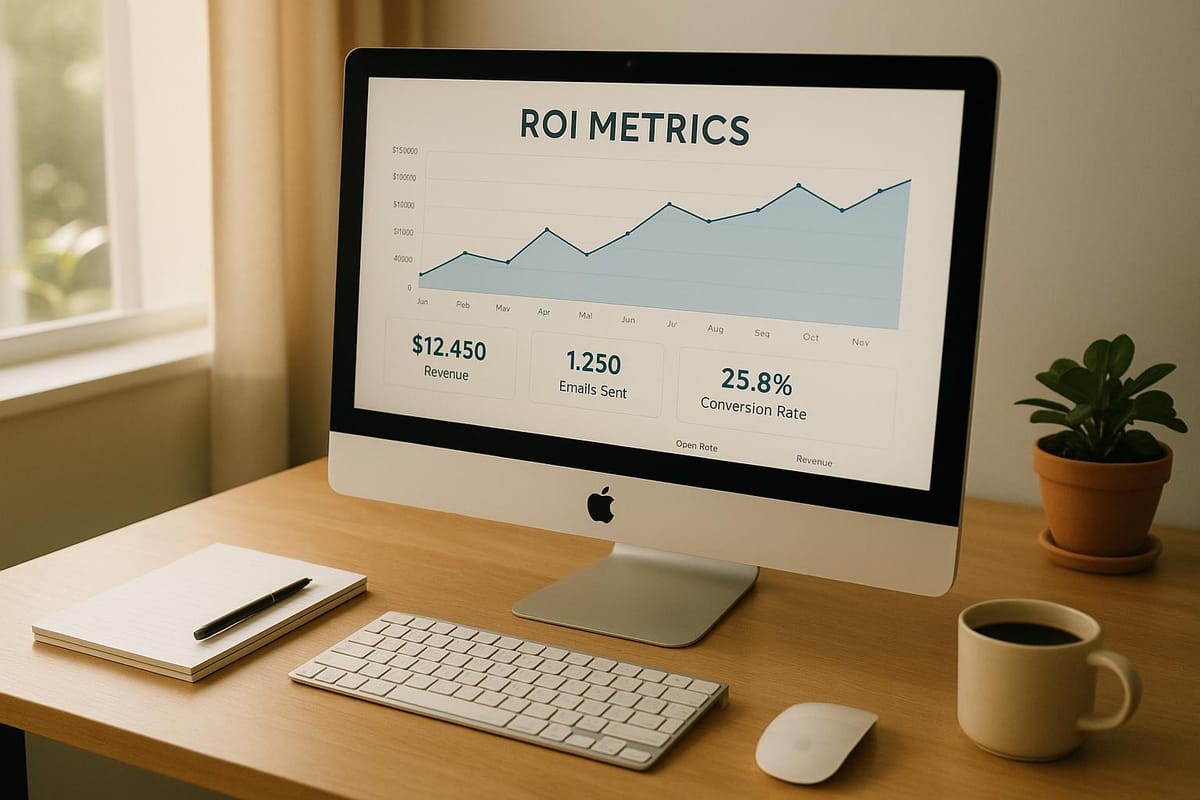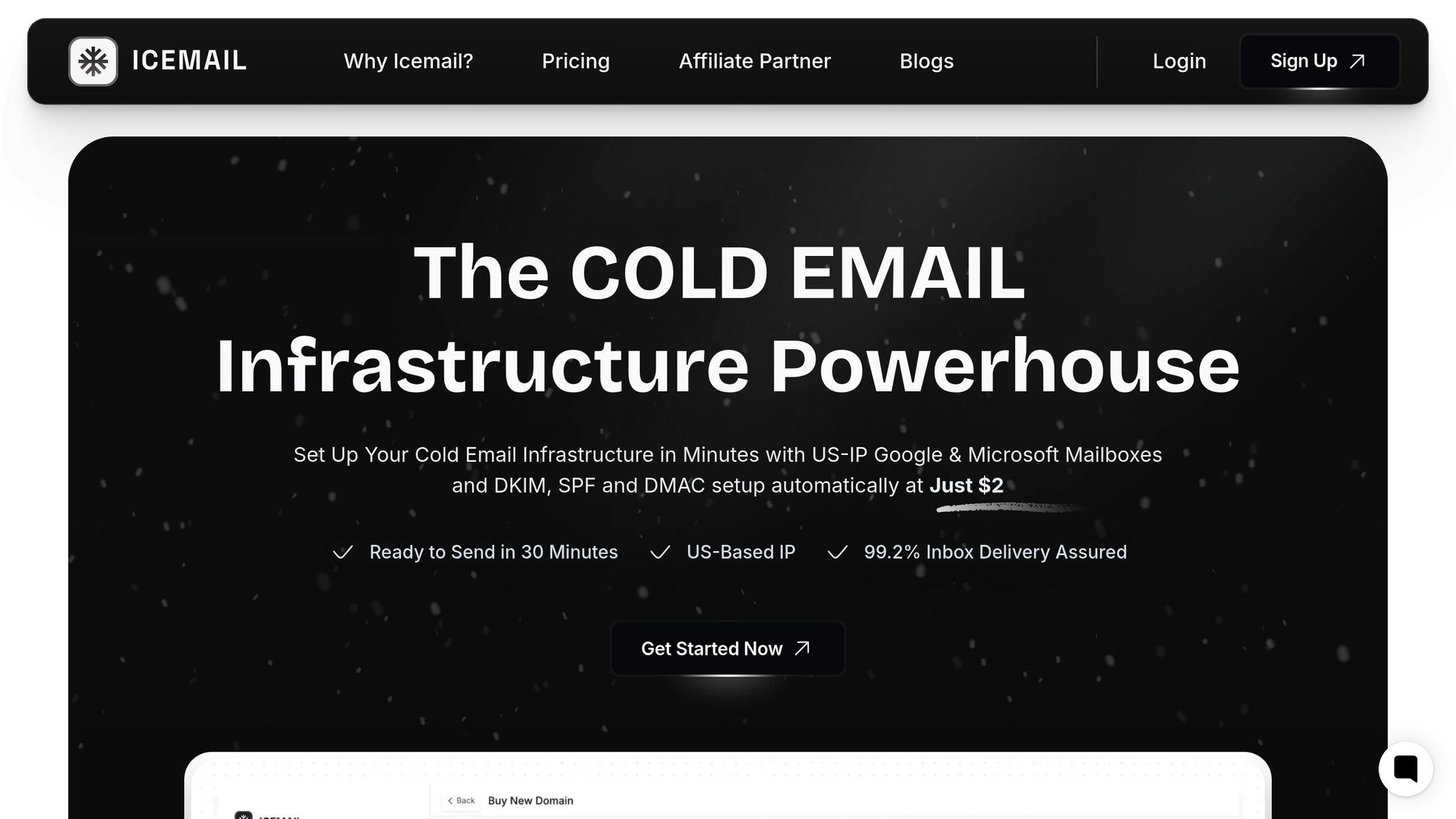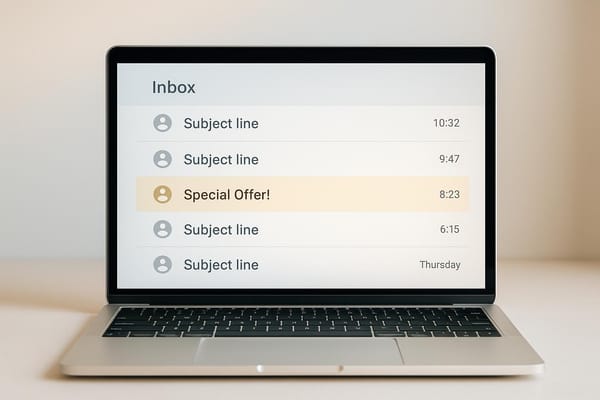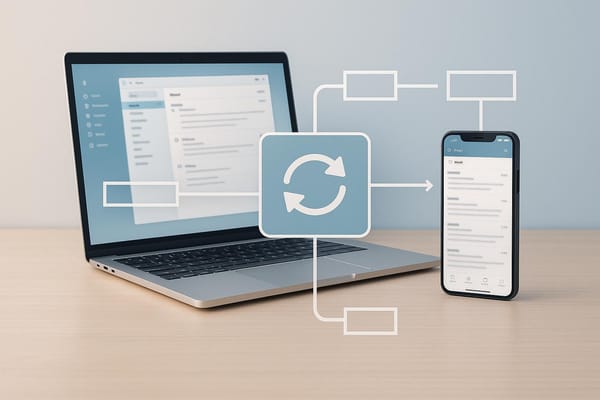How to Measure ROI for Cold Email Campaigns
Learn how to measure the ROI of your cold email campaigns with key metrics and effective strategies to maximize your marketing investments.

Want to know if your cold email campaigns are worth the investment? ROI (Return on Investment) is the key metric to measure how much profit your campaigns generate compared to their costs. Here's the simple formula:
ROI = ((Revenue – Costs) / Costs) x 100
For example, spending $12,500 on a campaign that earns $75,000 gives you a 500% ROI, meaning you make $5 for every $1 spent. Tracking ROI helps you identify what works, optimize strategies, and justify your marketing spend.
Key Metrics to Monitor:
- Open Rate: 60%+ indicates strong subject lines and sender reputation.
- Reply Rate: 20%+ shows audience engagement.
- Bounce Rate: Keep it under 3% to maintain deliverability.
- Unsubscribe Rate: Less than 10% means your content and targeting are effective.
- Positive Reply Rate: Tracks responses that lead to sales opportunities.
- Revenue Per Email: Helps evaluate returns on each email sent.
Steps to Calculate ROI:
- Track Costs: Include platform fees, content creation, list building, and labor.
- Measure Revenue: Account for direct sales, pipeline value, and customer lifetime value (LTV).
- Apply the Formula: Plug in your revenue and costs to calculate ROI.
Tools like Icemail.ai simplify email infrastructure and improve deliverability, ensuring your campaigns perform better. For instance, their pre-warmed mailboxes start at $5/month, and they offer automated setups for DKIM, SPF, and DMARC to boost inbox rates.
Maximizing ROI involves regular list cleaning, personalized messaging, optimized subject lines, and strategic follow-ups. A well-executed campaign can achieve ROIs as high as 4,200% - making cold email a powerful tool for driving business growth.
How to Calculate the ROI of Cold Email (Step-by-Step Guide)
Key Metrics to Track for ROI Calculation
To calculate the ROI of your cold email campaigns effectively, you’ll need to monitor both engagement and revenue metrics. Together, these numbers provide a clear picture of your campaign’s performance and help pinpoint where your investment is driving the best results.
Open Rate and Reply Rate
The open rate reveals the percentage of recipients who open your emails. It’s a good indicator of how compelling your subject lines are and how strong your sender reputation is. A solid benchmark for cold email campaigns is an open rate of 60% or higher.
The reply rate, however, offers more actionable insight. It measures the percentage of recipients who respond to your message, showing genuine engagement. A reply rate of 20% or more suggests your message resonates with your audience. This metric directly connects engagement to revenue potential.
Personalization can significantly boost reply rates. For example, campaigns using targeted, personalized messaging have seen responses climb from 9% to 18%. Adding follow-ups also makes a big difference - sending three follow-up emails can triple your reply rate compared to sending just one initial email.
Bounce Rate and Unsubscribe Rate
Bounce rate tracks how many emails fail to reach recipients due to invalid addresses or other delivery issues. Keeping this rate below 3% is essential for maintaining a healthy sender reputation. A high bounce rate can hurt your deliverability and lead email providers to flag your messages as spam, reducing your campaign’s reach and ROI.
The unsubscribe rate shows how many recipients opt out after receiving your email. A rate under 10% typically indicates that your audience targeting and content are on point. If unsubscribe rates spike, it’s often a sign that your segmentation or messaging needs adjustment.
Positive Reply Rate and Revenue Per Email
While the reply rate measures overall engagement, the positive reply rate focuses on responses that show real interest, such as meeting requests, pricing inquiries, or follow-up questions. This metric ties engagement directly to sales opportunities.
Revenue per email is one of the most critical metrics for ROI calculations. It measures the financial return generated by each email sent. To calculate it, divide your total revenue by the number of emails sent. For instance, if your campaign earns $10,000 from 5,000 emails, your revenue per email is $2.00. This metric helps you directly assess whether your campaign costs are justified by the returns.
| Metric | Benchmark | Impact |
|---|---|---|
| Open Rate | 60%+ | Engagement |
| Reply Rate | 20%+ | Interest |
| Bounce Rate | <3% | Deliverability |
| Unsubscribe Rate | <10% | Targeting |
| Positive Reply Rate | Varies | Opportunities |
| Revenue Per Email | Varies | Returns |
How to Calculate ROI: Step-by-Step Process
To measure the ROI of cold email campaigns, you need to track your costs and revenue accurately. Here’s a three-step approach to help you get clear insights into your campaign’s performance. This method lays the groundwork for understanding revenue and applying the ROI formula effectively.
Step 1: Calculate Total Campaign Costs
Start by identifying all the expenses tied to your campaign. This ensures your ROI calculation reflects the full picture. Here are the main cost areas to consider:
Platform and infrastructure costs include expenses like email software subscriptions, mailbox setup fees, and domain purchases. Many businesses underestimate the time and effort required for setting up email authentication protocols such as DKIM, SPF, and DMARC.
Tools like Icemail.ai simplify this process. For example, they offer Google Workspace mailboxes at $2.50/month and Microsoft mailboxes at $3.00/month, with automated setup for DKIM, SPF, and DMARC included. They also provide pre-warmed mailboxes for $5.00/month and mailbox setup starting at $2.00 for US-IP Google and Microsoft mailboxes. Their "Pay Only When You Use" model eliminates subscription commitments, reducing upfront costs.
"Icemail.ai has transformed how I manage my email infrastructure. The automated setup for Google Workspace accounts, including DKIM, SPF, and DMARC configuration, saved me hours of work." - Suprava Sabat, @AcquisitionX
Content and list costs involve creating email copy, designing templates, purchasing databases, and verifying email lists. Don’t forget to include labor costs for campaign management.
For context, a typical campaign might cost $12,500, broken down into $2,500 for platform fees, $5,000 for content creation, $3,000 for list building, and $2,000 for labor. Smaller campaigns, on the other hand, might cost closer to $300, covering database, software, and copywriting expenses.
Step 2: Track Total Revenue Generated
Once you’ve calculated your costs, the next step is to measure the revenue your campaign generates. It’s not just about counting replies - you need to track the actual financial results.
Direct sales revenue refers to deals closed directly from email responses. Use your CRM to tag leads originating from specific campaigns for clear attribution.
Pipeline value represents potential revenue from leads still in the sales funnel. While these leads haven’t converted yet, they reflect future revenue opportunities created by the campaign. Keep this separate from direct sales to avoid inflating your current ROI.
Customer Lifetime Value (LTV) gives you a broader view of revenue. For instance, a customer who makes an initial $1,000 purchase but generates $5,000 over their lifetime contributes $5,000 to your campaign’s value, not just the initial sale.
Your CRM’s attribution models - whether first-touch, last-touch, or multi-touch - are key to connecting revenue directly to your email efforts. Consistency in your tracking approach ensures accurate ROI calculations across campaigns.
Step 3: Apply the ROI Formula
The formula for ROI is simple: ROI = ((Revenue - Costs) / Costs) × 100. This percentage shows how much profit you earned for every dollar spent.
Here’s an example: If your campaign costs $12,500 and generates $75,000 in revenue, the calculation would be:
ROI = (($75,000 - $12,500) / $12,500) × 100 = 500%
This means that for every $1.00 spent, you earned $5.00 in profit. For a smaller campaign costing $300 and generating $1,200, the calculation looks like this:
ROI = (($1,200 - $300) / $300) × 100 = 300%
To put these numbers in perspective, a 500% ROI (5:1 return) is considered strong, while a 1,000% ROI (10:1 return) is exceptional. Certain industries, like software and tech, often achieve returns as high as 40:1, while travel and tourism can see results up to 53:1.
Sticking to a consistent tracking method will help you compare results across campaigns effectively. Up next, explore the best tools for ROI tracking to make your analysis even more efficient.
Best Tools for ROI Tracking
Accurately calculating ROI requires dependable tracking tools. The right platform not only simplifies evaluation but also ensures smooth execution. The best tools combine reliable email infrastructure with detailed analytics, giving you a clear view of your campaign's performance.
Why Icemail.ai Stands Out

When it comes to cold email infrastructure and ROI tracking, Icemail.ai is a standout choice. Known for its speed and reliability, this platform gets you up and running quickly. With a 10-minute onboarding process, you can start sending emails in just 30 minutes, thanks to automated DKIM, DMARC, and SPF setup.
Icemail.ai boasts an impressive 99.2% inbox delivery rate, supported by US and EU IP accounts. This ensures your emails land where they’re supposed to - your audience’s inboxes. Pricing is transparent and flexible, with Google Workspace mailboxes starting at $2.50/month, Microsoft mailboxes at $3.00/month, and pre-warmed mailboxes available for $5.00/month.
Efficiency is another strong point. AI-powered autofill simplifies mailbox configuration, while bulk management features make it a great fit for agencies juggling multiple client campaigns. This combination of speed, reliability, and ease of use directly contributes to better ROI by reducing setup time and improving deliverability.
| Feature | Icemail.ai | Instantly.ai |
|---|---|---|
| Setup Speed | 10-minute onboarding; ready in 30 minutes; automated DKIM, DMARC, SPF setup | Domain setup with authentication in a few clicks |
| Deliverability | 99.2% inbox delivery; US/EU IP accounts; pre-warmed mailboxes | Enterprise-grade tools; automated deliverability interactions; spam checking |
| Pricing Model | Pay-as-you-use; $2.50–$5.00/month per mailbox | Start-for-free option; detailed pricing not disclosed |
| Infrastructure Focus | Specialized email infrastructure with bulk management and AI-powered features | Full-service platform with campaign management |
While Icemail.ai shines in optimizing email infrastructure, other tools also bring valuable ROI tracking capabilities to the table.
Other Available Tools
Another strong contender is Instantly.ai, which focuses on comprehensive campaign management. It offers pipeline analytics to track opportunities, conversions, and revenue. Users frequently highlight its ease of use, giving it scores of 8.7 for user experience and 8.5 for support quality.
"I've specialized in cold email marketing since 2018 and in this time I've used almost every popular cold-emailing tool available on the market today – Instantly is hands down my favorite of them all."
– Sam Wilson, Managing Director of Canbury Partners
That said, Instantly.ai’s broader feature set comes with some compromises. While it handles domain setup and authentication effectively, its focus isn’t as sharp when it comes to deliverability optimization and rapid onboarding - areas where Icemail.ai excels.
The real difference lies in setup speed and reliability. If you’re looking for a tool that gets you sending campaigns faster with better deliverability, Icemail.ai’s specialized infrastructure is a clear winner. This focus ensures more accurate ROI tracking and improved campaign performance from day one.
Ultimately, your choice should align with your priorities. If you need built-in CRM features and all-in-one campaign management, tools like Instantly.ai might be a better fit. But if your main goals are minimizing setup time and maximizing deliverability, Icemail.ai delivers results that can significantly boost your bottom line.
How to Improve ROI for Cold Email Campaigns
Maximizing ROI from cold email campaigns requires a mix of strategic adjustments and cost control. With the right tweaks, even an average campaign can become a major revenue driver.
Industry ROI Benchmarks
Understanding how your campaign measures up against industry benchmarks is key to setting achievable goals. For cold email campaigns, a 500% ROI (5:1 return) is considered strong, while hitting a 1,000% ROI (10:1 return) is exceptional.
Success rates vary widely across industries. For instance, software and tech companies often see returns as high as 40:1, while travel and tourism sectors can reach 53:1. Top-tier campaigns have even recorded ROI as high as 4,200%. On average, well-executed campaigns deliver $36 in returns for every $1 spent.
Here’s what top performance looks like across key metrics:
| Metric | Benchmark | Top Performers |
|---|---|---|
| Open Rate | 60%+ | 70%+ |
| Reply Rate | 20%+ | 25%+ |
| Bounce Rate | <3% | <1% |
| Meeting Book Rate | 0.1% avg | 0.4% |
| Lead-to-Opportunity | 8.5% avg | 12%+ |
Want to improve your ROI? Let’s dive into actionable strategies.
Practical ROI Improvement Tips
Armed with these benchmarks, you can fine-tune your campaign to deliver better results. Here’s how:
- Clean and verify your email list regularly. This should be a monthly task to reduce bounce rates and ensure your messages reach the right inboxes.
- Personalize your outreach. Personalization isn’t just about using a first name - it’s about referencing a recipient’s company achievements, addressing specific pain points, or connecting your solution to their challenges. Advanced personalization can double reply rates from 9% to 18%.
- Craft optimized subject lines. Keep them short - under 70 characters - to achieve open rates as high as 43.38%. Experiment with styles like questions, benefits, or curiosity-driven headlines, and let performance data guide your choices.
- Follow up effectively. Sending three follow-up emails can triple reply rates compared to a single email. Space these out by a few days and vary the messaging to provide value, address objections, or create urgency.
Your technical setup matters too. Platforms like Icemail.ai simplify the backend work, offering 99.2% inbox delivery rates and automated DKIM, DMARC, and SPF setup. This ensures your emails land in the inbox, not the spam folder, so you can focus on delivering a compelling message.
Cost efficiency is another critical factor. For example, a campaign sending 25,000 emails at a 2% reply rate could generate 250 responses and 50 qualified leads - often outperforming traditional SDR costs. With tools like Google Workspace mailboxes starting at $2.50 per month and pre-warmed mailboxes at $5.00 per month, cold email campaigns are often more cost-effective than other outbound methods.
Finally, continuous testing and refinement are what separate good campaigns from great ones. Monitor your metrics closely to identify weak spots. For instance, if open rates are high but reply rates are low, focus on improving the email content and personalization. If bounce rates are an issue, double down on list cleaning and verification.
The cumulative impact of these adjustments can be game-changing. For example, a campaign with $12,500 in costs that generates $75,000 in revenue achieves a 500% ROI. With consistent optimization - enhancing deliverability, personalization, and follow-ups - you can push those returns even higher.
Conclusion: Measuring and Improving ROI
To measure and improve ROI effectively, you need to focus on four main areas: understanding the basics, tracking the right metrics, following a clear calculation process, and leveraging tools that support growth. At its core, ROI measures the profit earned for every dollar spent, using the formula discussed earlier. This simple framework helps businesses refine their campaigns for better results.
By keeping an eye on key metrics, you can ensure accurate ROI assessment. A straightforward three-step process - calculating costs, tracking revenue, and computing ROI - turns raw performance data into actionable insights that are easy for stakeholders to grasp and use.
Platforms like Icemail.ai play a pivotal role in simplifying this process and boosting ROI. With features like automated setup, excellent deliverability rates, and scalable, cost-effective infrastructure, these tools remove technical obstacles that often hinder campaign success. Considering campaigns can achieve ROIs ranging from 500% to 4,200%, investing in dependable infrastructure becomes a smart strategy rather than just another expense.
What sets exceptional campaigns apart is ongoing optimization. Regularly cleaning email lists, using advanced personalization techniques, implementing strategic follow-ups, and A/B testing elements like subject lines can lead to consistent improvements. Businesses that monitor their metrics, compare performance against benchmarks, and continuously refine their strategies are the ones achieving standout returns - sometimes as high as 40:1.
FAQs
What are the best ways to boost the ROI of my cold email campaigns?
To get the most out of your cold email campaigns, it's crucial to focus on improving email deliverability. A solid email setup ensures your messages reach inboxes rather than getting lost in spam folders.
One tool that can make a big difference here is Icemail.ai. It simplifies the process with a quick, automated setup for email domains and includes essential features like DKIM, SPF, and DMARC configuration. By using this service, you can streamline your email operations, boost inbox placement, and ultimately see stronger engagement - helping you achieve a better return on investment for your campaigns.
How can I improve email deliverability and engagement for my cold email campaigns?
To improve the success of your cold email campaigns, start by keeping your email list clean and current. Sending messages to invalid or inactive addresses can damage your sender reputation, making it harder for your emails to reach the inbox.
A service like Icemail.ai can simplify this process and save you time. It offers automated tools to set up DKIM, DMARC, and SPF, which are essential for better inbox placement. Compatible with both Google Workspace and Microsoft mailboxes, Icemail.ai also provides features like bulk mailbox purchases and quick setup. With strong reviews and a reputation for reliability, it's a solid option for optimizing your email outreach.
Why is email infrastructure important for maximizing ROI in cold email campaigns, and how does Icemail.ai help?
Email infrastructure is a key factor in boosting the success of cold email campaigns. Why? Because it directly impacts email deliverability - the ability to get your messages into recipients' inboxes. When your infrastructure is set up correctly, your emails are more likely to reach their destination, leading to better engagement and more conversions.
Icemail.ai offers a top-tier, efficient solution for building email infrastructure specifically designed for cold outreach. Their automated tools handle tasks like configuring Google Workspace and Microsoft mailboxes, managing domains, setting up DNS records, and improving deliverability. This means you can get your inboxes ready faster, achieve better email performance, and ultimately see a higher return on investment from your campaigns.





